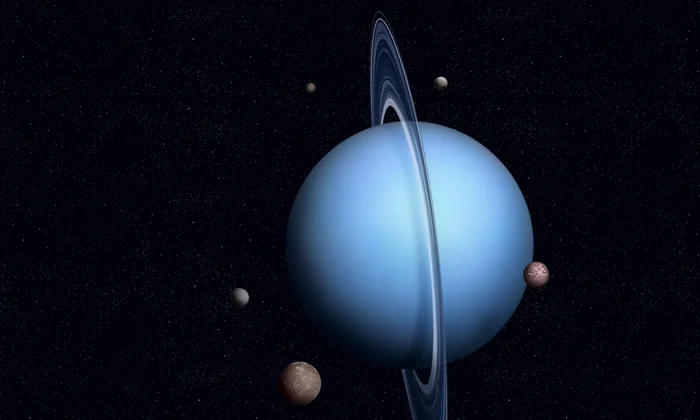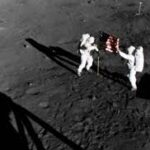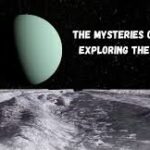Uranus, the seventh planet from the Sun, is one of the most mysterious and underexplored planets in our solar system. Known for its unique axial tilt, icy atmosphere, and pale blue appearance, Uranus also boasts an impressive collection of moons—27 known natural satellites that dance around this distant giant. In this 1000-word article, we dive deep into the fascinating world of Uranus‘ moons, exploring their discovery, characteristics, naming traditions, and the possibilities they hold for future exploration.
A Quick Overview of Uranus
Before we delve into its moons, it’s important to understand Uranus itself. Discovered in 1781 by William Herschel, Uranus is an ice giant primarily composed of hydrogen, helium, and methane. It has the coldest planetary atmosphere in the solar system and rotates on its side with an axial tilt of 98 degrees—making its seasons dramatically different from those on Earth.
But perhaps what makes Uranus even more intriguing is its moons. These natural satellites orbit the planet in complex, captivating patterns and offer a treasure trove of scientific curiosity.
Discovery of Uranus’ Moons
The first two Uranus moons, Titania and Oberon, were discovered in 1787 by William Herschel himself. However, it wasn’t until the mid-20th century that additional moons were identified with the help of advanced telescopic technology and spacecraft observations.
The Voyager 2 flyby in 1986 provided a significant leap in our understanding. Since then, ground-based observations and data analysis have increased the moon count to 27.
Naming the Moons of Uranus
Unlike the mythological naming scheme used for most of the solar system’s celestial bodies, Uranus’ moons are uniquely named after characters from the works of William Shakespeare and Alexander Pope. This tradition, started by Herschel’s son John Herschel, gives the Uranian system a literary flavor not found in other planetary systems.
Some of the most well-known Uranus moons and their literary inspirations include:
- Titania (from A Midsummer Night’s Dream)
- Oberon (also from A Midsummer Night’s Dream)
- Ariel (from Pope’s The Rape of the Lock and Shakespeare’s The Tempest)
- Umbriel (from The Rape of the Lock)
- Miranda (from The Tempest)
The Major Moons of Uranus
Among the 27 moons, five are considered major due to their size and geological features:
1. Titania
It features massive canyons, fault lines, and signs of past geological activity.
2. Oberon
Slightly smaller than Titania, Oberon is heavily cratered and darker in appearance. Its icy surface hints at a history of impacts and minimal geological activity.
3. Umbriel
This moon is notable for its very dark surface, possibly covered with carbon-rich material. It shows fewer signs of resurfacing compared to its siblings.
4. Ariel
. This suggests that it experienced tectonic and cryovolcanic activity in the past.
5. Miranda
Possibly the most fascinating Uranus moon, Miranda displays a bizarre and chaotic surface. It features massive cliffs (some of the tallest in the solar system), ridges, and patchwork terrain that puzzles scientists to this day.
The Inner and Outer Moons
In addition to the five major moons, Uranus is surrounded by a group of smaller inner and outer moons.
Inner Moons
These 13 small satellites lie closest to Uranus and orbit within its ring system. Examples include:
- Cordelia
- Ophelia
- Puck
- Cressida
These moons are irregularly shaped and likely composed of rock and ice. Their orbits help maintain the structure of Uranus’s faint ring system.
Outer Moons
Nine distant, irregularly-shaped moons orbit far from Uranus in highly inclined and eccentric orbits. These are likely captured objects from the Kuiper Belt or remnants from collisions.
Names include:
- Sycorax
- Caliban
- Prospero
- Setebos
These moons are small, dark, and only a few tens of kilometers in diameter.
Scientific Importance of Uranus’ Moons
The moons of Uranus offer an untapped opportunity to study icy bodies, ancient geological processes, and potentially subsurface oceans. Scientists believe that some of these moons, especially Ariel and Miranda, may have had—or still possess—liquid water beneath their surfaces.
Studying these moons can also shed light on the formation and evolution of ice giants and their satellite systems, which differ markedly from those of gas giants like Jupiter and Saturn.
Future Exploration of Uranus Moons
Despite the compelling mysteries it holds, the Uranus system remains one of the least explored in our solar system. Since Voyager 2’s flyby nearly 40 years ago, no spacecraft has returned to this region. However, NASA has recognized the importance of a Uranus orbiter and probe in its 2023–2032 Decadal Survey, listing it as a top priority for exploration.
A future mission could study Uranus’s moons in detail, orbit the planet, and deploy probes to the atmosphere and perhaps even landers on its moons. Such a mission would likely uncover new information about icy bodies, ring dynamics, and even astrobiological potential.
Final Thoughts
The Uranus moons represent one of the most fascinating and least understood collections of celestial bodies in our solar system. From the massive cliffs of Miranda to the dark craters of Umbriel, these icy satellites hold clues to the solar system’s history, evolution, and perhaps even the conditions necessary for life.
As humanity looks beyond Mars and Jupiter, Uranus and its moon family stand as a compelling destination—awaiting the next chapter of exploration and discovery. Unlocking the secrets of these distant moons may not only teach us about the outer planets but also the potential for life and change in the most unexpected corners of our cosmic neighborhood.



